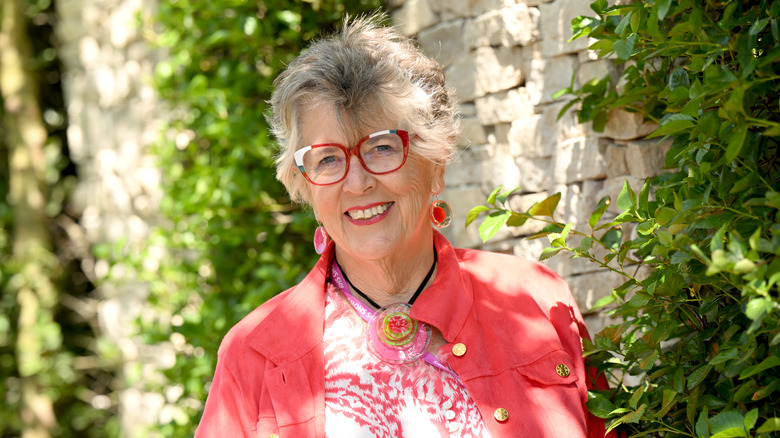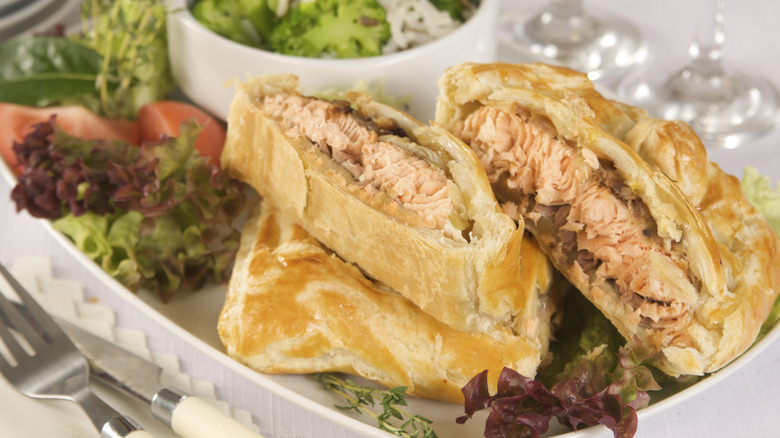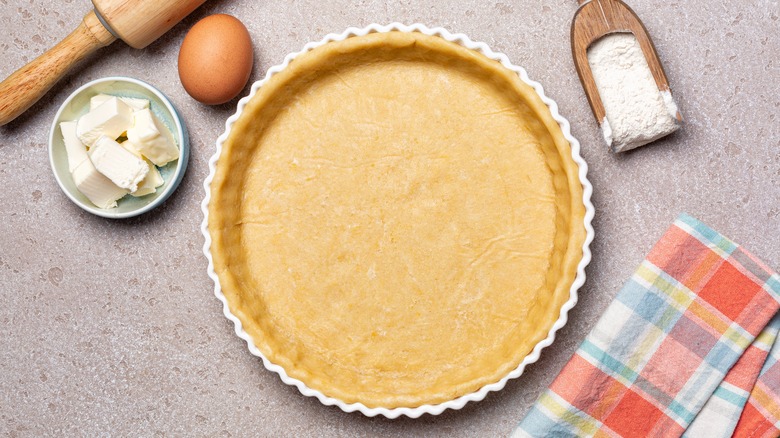Prue Leith's Pro Tips For Avoiding The Dreaded Soggy Bottom
We may receive a commission on purchases made from links.
Fans of "The Great British Baking Show," which kicked off Season 15 on Netflix, know co-host Prue Leith well. From her iconic colorful eyewear and wardrobe to her ability to transform from posh and aloof to goofy and caring in a heartbeat, the South African-born writer and TV personality has a knack for making an impression as well as impressive observations about food. Her list of "Baking Show" accomplishments doesn't include popularizing the term "soggy bottom" as a way to describe a wet or under-baked base on pies, tarts, and filled pastries — that honor goes to previous GBBS co-host Mary Berry. However, Leith has deftly applied it.
In Leith's new book "Life's Too Short To Stuff a Mushroom: Really Good Food Without The Fuss," she addresses the dreaded soggy bottom in a sidebar on salmon parcel pastries (think Beef Wellington, but with salmon). While her pro tips refer specifically to keeping moist fish tender while preventing baking juices from destroying the bottom of the pastry, it also works well when dealing with berries, custards, and other fillings. In short, Leith recommends pre-heating the baking sheet or sprinkling a layer of semolina inside the pastry before adding fish or other ingredients.
Preheat the baking sheet for a quick and easy fix
The goal of Prue Leith's cookbook is to provide quick and easy solutions to a myriad of issues people encounter in the kitchen. For "Baking Show" fans, the soggy bottom is one of the most daunting problems.
In a sidebar titled "Prue's Handy Hack," Leith suggests pre-heating the baking sheet. It's as simple as popping it in the oven while it's preheating to bring it to the same temperature. "Then when you put the pastry on the hot tray, it immediately starts cooking from underneath, and you will achieve a crisp, brown, bottom crust," she writes. In the case of salmon parcels, this works best if the parcels are individual servings.
If the pastry contains a whole salmon filet, you want to take another tack, since you've got both more juices and more surface area to deal with. In this case, Leith suggests spreading a layer of semolina meal or fine breadcrumbs on the bottom (inside) layer of the pastry, between fish and pastry. "This will absorb some of the juices and prevent them from sogging up the pastry," she explains.
Other tips for avoiding the soggy bottom
Prue Leith isn't the only Baking Show alumnus to lend a helping hand when it comes to avoiding soggy bottoms. Paul Hollywood, who's served as co-host for the entire run of the series, says blind baking works well for pie crusts. Essentially, you're pre-baking an empty bottom crust, using dried beans to keep the base flat. Fill it, add a top crust if desired, then bake the whole thing, ensuring you've done everything you could to keep the apple or cherry filling inside a perfect, flaky crust. If baking with beans seems weird, you could always use a non-food alternative, like these ceramic pie weights from FurRain that come with their own storage container.
When approaching a bake, you're considering a few factors. Are you baking a pie or a puff pastry? Is the filling sweet or savory? Are you dealing with juices that can burst or leak through a baking crust, or adding a custard or filling to a finished pastry? Each hack may be specific to a specific situation (like semolina inside the salmon parcel). With pie crusts and other pastries, another option is to brush the (inside) bottom with egg white in the final stages of blind baking. And Mary Barry, the original soggy bottom expert, suggests using a bit of remnant rolled pastry dough to the edge of a pie dish, raising the pie's base above the dish a bit (which helps bake the bottom).


